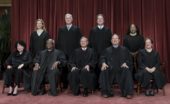Re Ian Bremmer 'Could third-party candidates upend the 2024 US election?' 3 April The current political movement in the USA…
SCOTUS and the US courts 2019
Written by Diana Thebaud Nicholson // May 28, 2019 // Justice & Law // Comments Off on SCOTUS and the US courts 2019
Supreme Court of the United States
SCOTUS & Brett Kavanaugh
SCOTUS and the US courts 2017-18
The Supreme Court Dodges an Abortion Case
The majority has managed to deal with a contentious issue by not really dealing with it at all.
By Garrett Epps, Professor of constitutional law at the University of Baltimore
(The Atlantic) Self-muzzling seems to be what the Supreme Court has done so far this term in the contentious area of abortion, now boiling over in the states. In February the Court granted a temporary stay of a Louisiana abortion law that would have put five of the state’s six abortion providers out of business. But Chief Justice John Roberts, who cast the deciding vote, gave no hint of how he would vote on the law when the Court gave the case full consideration. And on Tuesday, the Court dodged the validity of an Indiana statute that required abortion clinics to dispose of an aborted fetus in much the same manner as the body of a dead person; and, second, required doctors to tell women seeking abortion that state law forbade choosing abortion “solely because of the fetus’s race, color, national origin, ancestry, sex, or diagnosis or potential diagnosis of the fetus having Down syndrome or any other disability.”
McConnell Blocked Supreme Court Nominee in 2016, But Says He Would Fill Potential Vacancy in 2020
(New York) After the death of Justice Antonin Scalia in February 2016, Senate Majority Leader Mitch McConnell cemented his reputation as the no-man to President Obama by denying the rightful Senate hearings of Supreme Court nominee Merrick Garland. “The American people should have a voice in the selection of their next Supreme Court Justice,” McConnell said. “Therefore, this vacancy should not be filled until we have a new president.”
Not one to be beholden to inconvenient logic, on Tuesday, McConnell reversed his position — which he once called one of his “proudest moments.” Attending a local Chamber of Commerce luncheon in Kentucky, McConnell was asked: “Should a Supreme Court justice die next year, what will your position be on filling that spot?”
26 March
The ‘Enigma’ Who Is the Chief Justice of the United States
(NYT) Adam Cohen’s review of THE CHIEF – The Life and Turbulent Times of Chief Justice John Roberts, by Joan Biskupic
When the Supreme Court upheld the Affordable Care Act in 2012, Chief Justice John Roberts provided the critical fifth vote, enraging conservatives and delighting liberals. Ever since, questions have swirled around his vote. How could a jurist who was so carefully vetted for ideological purity have turned apostate on such a defining issue, saving Obamacare from oblivion?
In “The Chief,” her assiduously reported and briskly written biography, Joan Biskupic, a CNN analyst who has long covered the court, offers new behind-the-scenes details. Roberts was, she says, initially inclined to strike down a key part of the law, the individual mandate, which required people to have insurance or pay a penalty. But during the opinion-drafting process he joined the liberals in affirming it.
Biskupic all but throws up her hands toward the end of her narrative, calling Roberts an “enigma,” but she suggests that he is pulled by two often-conflicting instincts. One is ideological: a desire to move the court rightward on race, religion and other issues. The other is institutional: an interest in the court being respected and seen as nonpolitical.
(Reuters) The Supreme Court will hear arguments over the contentious practice of partisan gerrymandering – the manipulation of electoral district boundaries to entrench one party in power – today. After failing to deliver a definitive ruling on the legality of the practice last year, justices will get another chance in cases challenging North Carolina’s Republican-drawn statewide U.S. House of Representatives map and a single Democratic-drawn House district in Maryland. .
19 March
The real reason the Trump administration is constantly losing in court
(WaPo) Federal judges have ruled against the Trump administration at least 63 times over the past two years, an extraordinary record of legal defeat that has stymied large parts of the president’s agenda on the environment, immigration and other matters.
In case after case, judges have rebuked Trump officials for failing to follow the most basic rules of governance for shifting policy, including providing legitimate explanations supported by facts and, where required, public input.
Many of the cases are in early stages and subject to reversal. For example, the Supreme Court permitted a version of President Trump’s ban on travelers from certain predominantly Muslim nations to take effect after lower-court judges blocked the travel ban as discriminatory.
But regardless of whether the administration ultimately prevails, the rulings so far paint a remarkable portrait of a government rushing to implement far-reaching changes in policy without regard for long-standing rules against arbitrary and capricious behavior.
Two-thirds of the cases accuse the Trump administration of violating the Administrative Procedure Act (APA), a nearly 73-year-old law that forms the primary bulwark against arbitrary rule. The normal “win rate” for the government in such cases is about 70 percent, according to analysts and studies. But as of mid-January, a database maintained by the Institute for Policy Integrity at the New York University School of Law shows Trump’s win rate at about 6 percent.
(The Atlantic) The issue of racial discrimination in jury selection is at the heart of Flowers v. Mississippi, argued before the U.S. Supreme Court on Wednesday. Curtis Flowers, who is black, has been tried six times in two decades in the state of Mississippi, over a 1996 murder of four people. His lawyer is arguing that the white state prosecutor Doug Evans repeatedly, deliberately removed potential black jurors from the case, because of their race. Even if Flowers wins this case, he still might not be freed, Garrett Epps notes: The same prosecutor could try him on the same charges, yet again.
Thomas asks question for second time in a decade at Supreme Court
14 March
Why Kavanaugh Replacement Neomi Rao Is So Controversial
(New York) Confirmations to the D.C. Circuit Court of Appeals don’t usually generate big headlines, even when they aren’t competing with a massive college admissions scandal and various presidential scandals. But Neomi Rao’s confirmation to the position vacated by Supreme Court Justice Brett Kavanaugh shouldn’t be overlooked. The Senate’s 53-46 vote on Wednesday gives Rao, who once clerked for Supreme Court Justice Clarence Thomas, one of the most consequential judicial assignments in the country. Since she’s only 45 years old, she’ll likely be on the court for a long time, which also sets her up well for a future nomination to the U.S. Supreme Court.
The archconservative Thomas lobbied for Rao’s confirmation, and as one might expect, her political views place her firmly on the far-right end of the political spectrum. Here’s a look at the decisions and opinions that made her such a controversial pick, even among Trump nominees.
9 March
Racial Bias Doesn’t Fully Explain Manafort’s Sentence. It’s Unchecked Judges.
Inequities exist, but judges have an extraordinary amount of latitude. And they know they won’t be challenged.
(Politico) The 47-month sentence imposed on former Trump campaign chairman Paul Manafort has drawn widespread criticism that Judge T.S. Ellis’s decision to give Manafort a sentence far below the 19.5 to 24.5-year guidelines range was motivated by Manafort’s race and class or by partisan bias. In fact, his flawed decision is a consequence of the vast discretion given to federal judges to issue sentences without real fear of being overturned.
7 March
Clarence Thomas Is in the Wrong Line of Work
He thinks he alone knows the right answer—and that’s not a good attitude for a judge.
(The Atlantic) As Adam Liptak lays out in Tuesday’s New York Times, in a two-week period, Thomas managed to attack the basis of American press freedom and negate the right to appointed counsel for criminal defendants. He also casually suggested that the Supreme Court redo not only Roe v. Wade but virtually all its individual-rights decisions since at least 1938. Even this most radical of justices has scored a personal best.
His judicial philosophy is unusual, a brand of “originalism” that purports to find the “original public meaning” of constitutional provisions in an eccentric jumble of American and British sources. For example, he explained his vote in the same-sex marriage cases as flowing from the medieval Latin of the Magna Carta; in Brown v. Entertainment Merchants Association, he argued that the First Amendment allows states to ban sales of violent video games to minors by drawing on principles for Christian parents laid out in the Puritan Cotton Mather’s 1699 child-rearing manual, A Family Well-Ordered.
6 March
Senate Confirms Dangerous Religious Extremist Allison Rushing As Federal Judge
Before being confirmed Rushing worked for the Alliance Defending Freedom, a conservative Christian organization that has been classified as a hate group by the Southern Poverty Law Center.
In her writings, she has rejected the separation of church and state while arguing that “village secularists” and other “offended observers” should not be allowed to challenge government actions that violate the Establishment Clause which guarantees the separation of church and state.
5 March
‘Corporations Are People’ Is Built on an Incredible 19th-Century Lie
How a farcical series of events in the 1880s produced an enduring and controversial legal precedent
(The Atlantic) Somewhat unintuitively, American corporations today enjoy many of the same rights as American citizens. Both, for instance, are entitled to the freedom of speech and the freedom of religion. How exactly did corporations come to be understood as “people” bestowed with the most fundamental constitutional rights? The answer can be found in a bizarre—even farcical—series of lawsuits over 130 years ago involving a lawyer who lied to the Supreme Court, an ethically challenged justice, and one of the most powerful corporations of the day.



